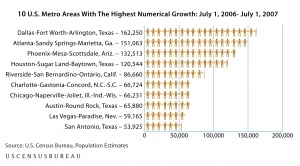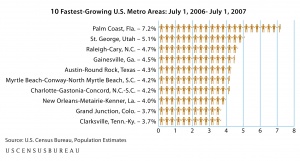City of Palm Coast Fastest Growing City in U.S. – Full Story
Palm Coast was not only the fastest growing city from 2006 – 2007, it’s also the fastest growing city from 2000 – 2007. See how your former home town stacks up.
March 31, 2008 – Palm Coast, FL – The U. S. Census Bureau released their annual estimate of metropolitan growth. Palm Coast, Florida ranked number one in percentage population growth for the period July 1, 2006 to July 1, 2007 (7.2%). More impressively, it also ranked number one for the 2000 – 2007 period with a growth rate of 77.4%.
Not only does the median selling price of single-family homes in the area (Flagler County) remain below that of Florida overall, it remains below that of the country. It is the least expensive warm climate location on the east coast. Palm Coast also sits at the point where Interstate 95 is at its closest proximity to the Atlantic Ocean. It should not surprise anyone that The City of Palm Coast is also growing fast. And Moody’s Economy.com projects the trend to continue through the next five years (see related story).
Dallas-Fort Worth had the largest numeric gain of any metro area between 2006 and 2007, increasing by 162,250, according to July 1, 2007, estimates of metro area population size and growth released today by the U.S. Census Bureau. Atlanta (151,063), Phoenix (132,513) and Houston (120,544) rounded out the metro areas with a gain of at least 100,000.
 The Midwest metro area with the greatest numeric change between July 1, 2006, and July 1, 2007, was Chicago (seventh overall nationally), while the Northeast metro area with the greatest numeric change over the same period was New York (21st overall nationally). (See Table 1 [Excel].)
The Midwest metro area with the greatest numeric change between July 1, 2006, and July 1, 2007, was Chicago (seventh overall nationally), while the Northeast metro area with the greatest numeric change over the same period was New York (21st overall nationally). (See Table 1 [Excel].)Eight of the 10 fastest-growing metro areas between 2006 and 2007 were located in the South. (See Table 2 [Excel].)
Four of these fast-growing Southern metro areas were not only among the top 10 in percent growth from 2006 to 2007 but also among the 20 largest numeric gainers during the same period. Raleigh, N.C., was the third fastest-growing metro area, 4.7 percent, as well as the 12th largest numeric gainer, at 47,052. Austin, Texas, was the fifth fastest-growing metro area, 4.3 percent, as well as the eighth largest numeric gainer, at 65,880. Charlotte, N.C.-S.C., was the seventh fastest-growing metro area, 4.2 percent, as well as the sixth-largest numeric gainer, at 66,724.
 The fourth metro area in the South, New Orleans, was the eighth-fastest growing metro area between July 1, 2006, and July 1, 2007, as its population climbed 4 percent. It also was the 16th largest numeric gainer over the same period, with an increase of 39,885. The metro area previously had the highest rate of decline between July 1, 2005, and July 1, 2006.
The fourth metro area in the South, New Orleans, was the eighth-fastest growing metro area between July 1, 2006, and July 1, 2007, as its population climbed 4 percent. It also was the 16th largest numeric gainer over the same period, with an increase of 39,885. The metro area previously had the highest rate of decline between July 1, 2005, and July 1, 2006. In addition to New Orleans, other Gulf Coast metro areas where populations increased between 2006 and 2007 after having experienced 2005-2006 population declines included Gulfport-Biloxi, Miss. (1.8 percent population growth from 2006 to 2007); Pascagoula, Miss., (1.6 percent); Beaumont-Port Arthur, Texas (0.5 percent); and Lake Charles, La. (0.4 percent).
The 50 fastest-growing metro areas were concentrated in two regions — 27 in the South and 20 in the West. One metro area, Fayetteville, Ark.-Mo., straddled both the South and Midwest regions. Sioux Falls, S.D., and Springfield, Mo., were the two metro areas among the 50 fastest-growing located completely in the Midwest. None of the 50 was in the Northeast. That region’s fastest-growing metro area was York, Pa., which ranked 107th.
New York was the most populous metro area on July 1, 2007, with 18.8 million people, followed by Los Angeles (12.9 million) and Chicago (9.5 million). Nine metro areas had 2007 populations of 5 million or more
More than four-fifths of all U.S. metro areas (303 out of 363) had a larger population on July 1, 2007, than on July 1, 2006. The 50 fastest-growing metro areas grew by at least 2.3 percent during this period, which is more than double the nation’s total population gain of 1 percent. As of July 1, 2007, the 363 metro areas in the United States contained 251.9 million people — 83.5 percent of the nation’s population.
See how your former home town stacks up
City Growth and Rank 2006 – 2007 Complete Chart
City Growth and Rank 2000 – 2007 Completre Chart

Estimate based on permits, not residents
The US Census Bureau estimate relies on a methodology that uses the number of building permits issued in the previous 6-month period – in this case calendar year 2006 – and multiplies it by the persons per household figure from the 2000 census (as adjusted in 2005). Bottom line, the population increase being touted is nothing more than a reflection of the high permitting numbers in the first half of calendar year 2006. How many of these permitted homes and condos were not built? How many were built but remain unoccupied? How many are in foreclosure? I suspect that if these adjustments were made, a different picture would emerge which would suggest that we should be dealing with an entirely different set of governmental priorities. I sincerely hope that these latest numbers are not used by City officials as justification to continue to increase development fees and erect new obstacles labeled as \”growth controls\” to block new investment in this community. The top priority of Palm Coast and county government needs to be on economic development and the creation and retention of quality jobs.